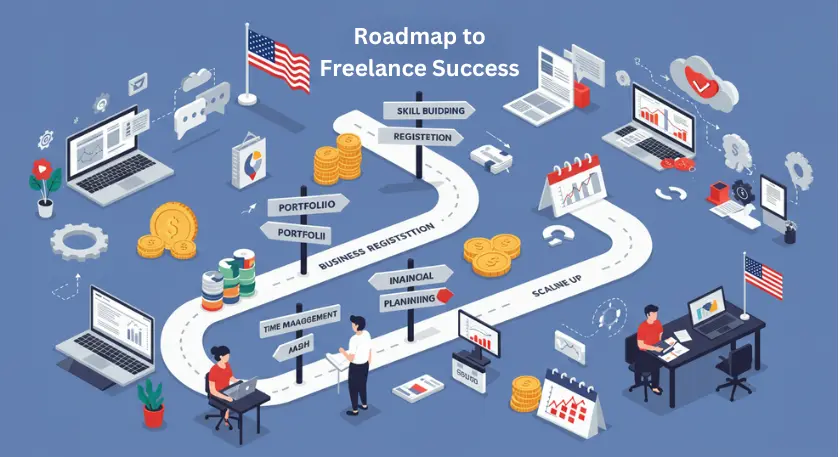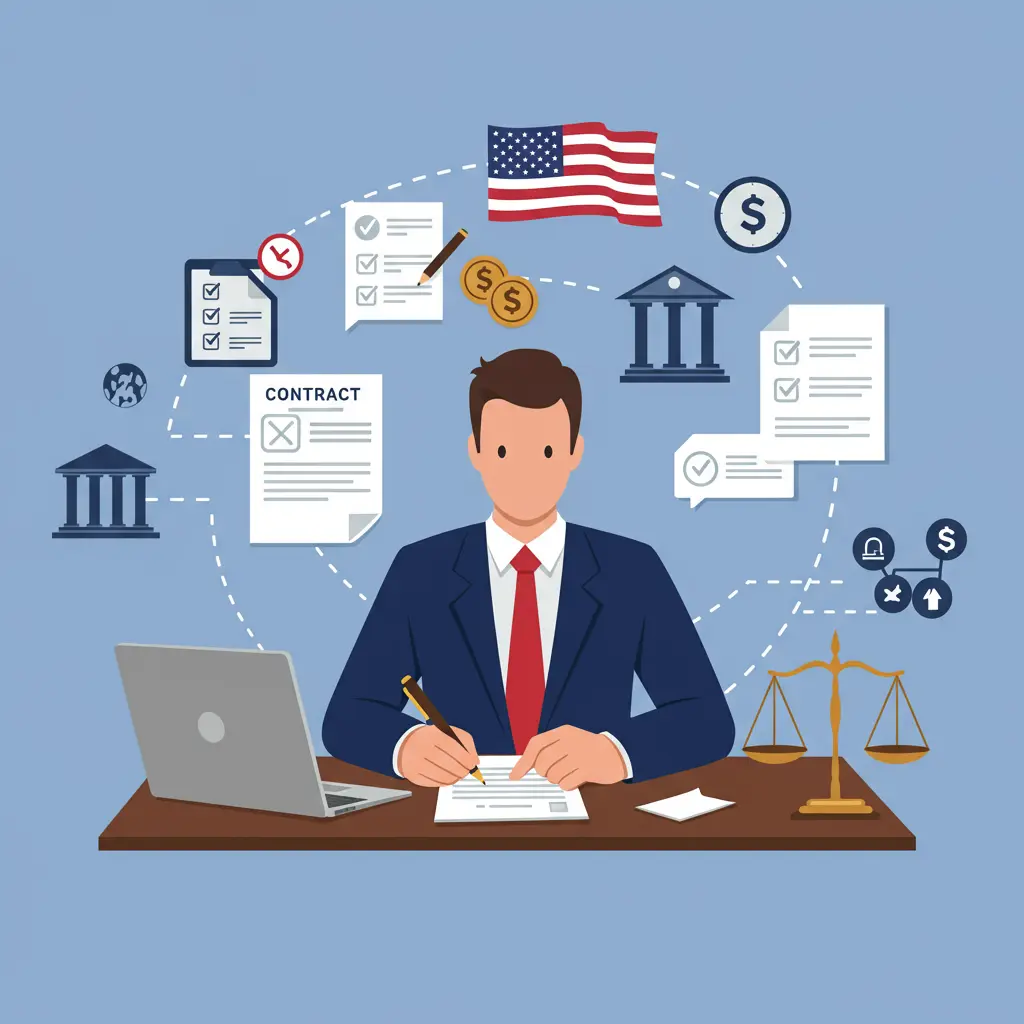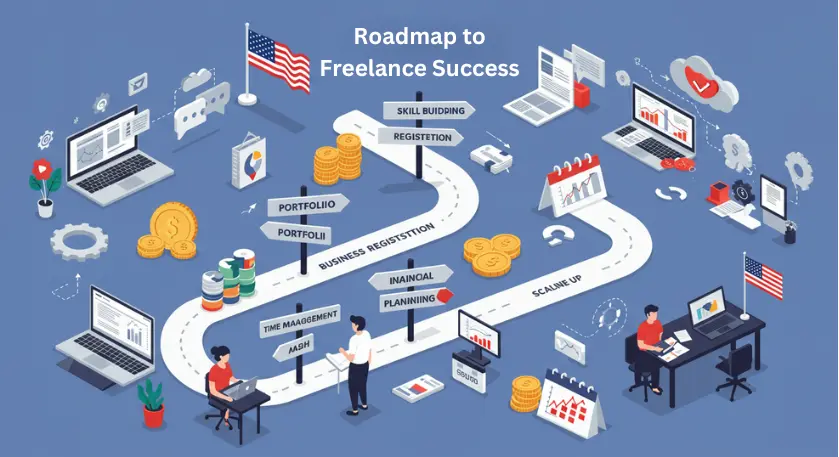The American freelance economy isn’t just booming. it’s metamorphosing.

Once perceived as a transitory hustle or a side gig for moonlighters, freelancing has now cemented itself as a full fledged career path. The U.S. boasts over 60 million freelancers and that number is only climbing. For beginners, however, the road to freelance success can appear labyrinthine. This roadmap untangles the chaos.
Step 1: Identifying Your Marketable Skills
Clarity is essential before money is exchanged or contracts are signed. Do a self evaluation first. What are some of your remarkable skills that others are willing to pay for? It could be voice acting, digital marketing, UI design, writing or even coding. Make a list of everything, then focus on the things that can be scaled and made profitable.
Examine the demand in the market. Web developers, SEO specialists, email marketers, virtual assistants and financial consultants are in high demand in the U.S. freelancing market right now. Adopt a niche. Specialists earn premium rates, whereas generalists compete on pricing.
Step 2: Setting Up a Professional Foundation
The first impression can’t be half baked. Build a clean, compelling resume tailored to freelance gigs not traditional employment. Include client testimonials (even if pro bono) and link to an online portfolio. No portfolio yet? Make one. Create mock projects or volunteer for nonprofits.
Then gear up. A beginner friendly tech stack might include tools like Notion or Trello for project management, Grammarly for writing, Canva for design and Google Workspace for email and cloud collaboration. Investing in the right tools isn’t frivolous. it’s foundational.
Roadmap to Freelance Success in the U.S
Step 3: Legalizing Your Freelance Operation

Legitimacy is crucial for building trust and protecting both parties. Begin by choosing the right business structure: sole proprietorship, LLC or S-corp. Many freelancers start as sole proprietors due to simplicity, then upgrade to LLCs for liability protection. Employer Identification Number (EIN) from the IRS. it’s free and essential for tax purposes.
Professionalism is not optional. Always use clear, written contracts outlining work of scope , payment terms, intellectual property rights and deadlines . Contracts are not just formalities. they are your safety net. Skipping this step exposes you to disputes and legal risks. Structure and documentation are the foundation of a sustainable freelance career.
Step 4: Pricing Your Services Strategically
New freelancers often underprice out of fear. Don’t. Low balling cheapens your value and attracts low-quality clients. Instead, research industry rates and consider value based pricing charging according to the results you deliver rather than hours worked.
Factor in taxes, software costs, health insurance and time spent on unpaid admin work. A simple formula: Hourly rate = (desired annual salary + expenses) ÷ billable hours. But always price for value not just time.
Step 5: Finding and Winning Clients
Clients won’t magically appear. Start on vetted platforms like Upwork, Contra or Toptal to build your track record. But don’t limit yourself email outreach and LinkedIn networking often yield higher paying gigs.
Your pitch should be concise, specific and client focused. Instead of “I am a designer,” try “I help SaaS startups boost user retention through intuitive UI/UX design.” Tailor each message and include a strong call to action.
https://ruul.io/blog/how-to-become-a-freelancer
Step 6: Building a Personal Brand

Personal branding serves as your guiding light in a crowded market. Share insightful case studies on LinkedIn, host free webinars or write informative blog posts to showcase your expertise. Virality isn’t the goal consistency and relevance are. Position yourself as a trusted authority in your niche through steady, value driven content.
Use platforms like Instagram, TikTok and Twitter wisely to expand your reach. Follow the 80/20 rule: 80% educational content, 20% self-promotion. People remember those who teach and add value not those who constantly sell. A strong personal brand builds credibility, attracts clients and sets you apart from the noise.
Step 7: Managing Time and Projects Effectively
Freelancing offers freedom but without structure, that freedom can spiral into disorder. Establish a daily routine and follow it with discipline. Tools like Toggl or Harvest help track time, while Asana or ClickUp keep tasks organized and deadlines visible. To prevent burnout, batch similar tasks, define clear work hours and eliminate distractions.
Structure fuels consistency which is key to long term success.it’s a steady, sustained effort. Treat your time as a valuable asset and create systems that support focus and efficiency. Discipline turns chaotic freedom into productive independence.
Step 8: Creating Client Relationships That Last
Repeat clients are invaluable building strong, long term relationships saves time, boosts income and enhances reputation. To foster longevity, manage expectations from the start and always overcommunicate. Keep clients updated proactively, even if there’s no urgent news. this builds trust and reliability. Clients value those who are consistent and dependable.
At the same time, set clear boundaries early to avoid scope creep and burnout. Once you have earned a client’s trust, don’t hesitate to upsell them on monthly retainers or long term projects. Retaining a satisfied client is far easier and more profitable than constantly searching for new ones. Prioritize relationships not just transactions.
Step 9: Financial Management for Freelancers
Income inconsistency is one of the biggest challenges in freelancing but it can be managed with smart financial habits. Start by budgeting carefully apps like YNAB or Wave can help you track every dollar. Always set aside 25–30% of your income for taxes to avoid surprises.
Plan ahead: open a SEP IRA or Roth IRA for retirement, explore ACA health insurance options and build an emergency fund that covers at least three months of living expenses. True freelance freedom comes with financial stability. When your money is managed well, you gain peace of mind and the freedom to grow your business.
Step 10: Scaling from Freelancer to Business Owner

Your systems need to change as your freelance workload grows. Recognize when it’s better to subcontract and when to decline additional job. Create a trustworthy virtual team or network of knowledgeable partners. To save time and cut down on mistakes, automate repetitive operations using programs like Zapier or Dubsado.
Out source administrative labor wherever you can to free up your time for high-value projects. Remember that true progress involves working more efficiently and intelligently not merely taking on more projects. The secret to successfully and sustainably growing your freelance business is efficiency, delegation and intelligent processes.
Conclusion:
Freelancing in the U.S. can be a rewarding and profitable career but it’s far from an overnight success story. It demands deep self awareness, careful planning, strong personal branding and consistent execution. To thrive, treat freelancing like a serious business not just a side gig. Build resilient systems, stay flexible in a changing market and focus on long term relationships over one time transactions.
The most successful freelancers are intentional with their goals, client communication and growth strategies. Remember, it’s not about how fast you start it’s about how well you build. Sustainability, strategy and consistency are what truly lead to lasting success.
Q: How do I know which skills are marketable?
A: Research in-demand skills on freelance platforms like Upwork or Fiverr and match them with your strengths.
Q: What tools do I need to start freelancing professionally?
A: A portfolio website, professional email, LinkedIn profile and invoicing software.
Q: Do I need to register my freelance work as a business?
A: Yes, for legal protection and tax benefits, consider registering as an LLC or sole proprietorship.
Q: Should I charge hourly or per project?
A: It depends hourly is good for short tasks, while project-based is better for defined deliverables.
